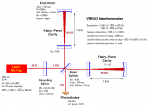The Virgo interferometer is a project in which LAPP is involved since 1990. It has been funded in 1992 by France CNRS and Italy INFN and its construction has started in 1994 in the county of Cascina, near Pisa. The various steps of site acquisition, the infrastructure works, the installation and the commissioning of the instrument have required many years and have finally allowed a first scientific run in 2007.
The Virgo detector reached in 2011 a sensitivity better than 10-19 m/sqrt(Hz) for frequencies above 50 Hz. This can be translated into an ability to detect gravitational waves from binary neutron stars as far as 40 millions light-years (12 Mpc).
In 2011, having reached the limits of what could be done with Virgo as a first generation instrument, the detector’s operation has been stopped in order to proceed with major modifications to improve significantly the sensitivity. The improved instrument, Advanced Virgo, has taken data during August 2017 and participated to the detection of GW170817, a binary neutron star coalescence which initiated the multi-messager astronomy.
Since then, several other detections have been made in coincidence between Advanced Virgo and the Advanced LIGO interferometers, over the O3 run which lasted from April 2019 to March 2020. And an improved version, Advanced Virgo+, is under installation and commissioning for a new run O4, which should start on Easter 2022.
Listen to gravitational waves: The laser light beam at the output of the Virgo interferometer contains a signal which is in the audio frequency domain and can thus be transformed into an audible signal. You can already exercize your ear for a gravitational waves hunt, thanks to the black hole hunter
















